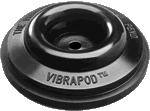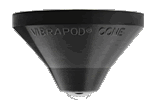The Vibrapod Company
623 Hanley Industrial Court
St. Louis, MO 63144
Phone (314) 645-2900
Fax (314) 645-6700
|
Reprinted
from

Issue 118 -- -------- June
/July 1999
|
|
Vibrapods
& Loudspeaker Serendipity
|
According to Webster,
“serendipity” is “the apparent aptitude for making fortunate discoveries
accidentally.” An example might be the clumsy cave man who was the first
to drop a piece of Mastodon meat into the fire and thereby discovered
– the barbecue! So it is that I wonder how many seemingly implausible
tweaks may have been stumbled across by accident, or in the process
of aiming at something completely different! Most tweaks focus on eliminating
something unwanted, mainly resonance (or the effects of resonance on
surrounding devices), by stabilizing something. Thus we have a myriad
of suspension devices and sound-damping or deadening treatments. And
most manufacturers today equip their speakers with stands or spikes
and the means to attach them. Yet most audiophiles would agree that
achieving optimal speaker setup seems to be a maddeningly elusive goal.Well,
the good news is that something has come along to significantly affect
loudspeaker performance, achieving a quantum-leap improvement through
the elimination of micro-resonance that most of us don’t even realize
is there until it goes away! And the whole thing happened quite by accident,
using a product that itself was created by accident.
One
day in a factory in St. Louis, Missouri, a CD player skipped. Now this
factory, which happens to be owned by audiophile Sam Kennard, produces
something called Flexible Vinyl Grommets – that is, collars used to
attach tubes or pipes to sheet metal and provide a cushioning effect
to absorb vibration and noise. It also happened that one of Kennard’s
employees (also an audiophile) had often observed the leftover scrap
vinyl and mused “Wouldn’t it be wonderful if we could use this stuff
somewhere in audio?” And so, the Day the CD Skipped, Kennard got the
idea to try a few of his flexible grommets under the CD player, and
– voilà! – no more skipping (not to mention that they all agreed it
sounded better, too, with “smoother treble, more open and spacious midrange
and better-defined bass”). Kennard then tried them under his turntable
with equally pleasing results and decided this was too good to keep
to himself. So, after about a month of experimentation, testing, and
modifying, he arrived at the design that is now the Vibrapod Isolator
– a small (2-inch diameter!), saucer-shaped, flexible vinyl disc. Listening
tests seemed conclusive, proving that the composition was indeed effective
against “horizontally induced resonances” and would thereby improve
the microdynamics of components of all kinds. The tests also led to
the development of different densities – soft to hard – to accommodate
light versus heavy components. Thus, the current lineup includes five
“models,” which differ only in tensile strength, not physical size,
to accommodate weights ranging from 2 to 28 pounds.
I was
sent a full complement of Vibrapods to experiment with, and did so under
virtually every component in my system, according to instructions (look
at www.vibrapod.com for details). The weight and bulk of the turntable
kept me from moving it around to compare it with versus without, so
I can’t say anything definitive about that, but it did seem that the
most audible results were obtained under the CD player. Perhaps this
is because a CD player has an electromechanical function with moving
parts (i.e., the transport) that are inherently more susceptible to
self-generated vibrations. Nevertheless, there was no question that
the sound was smoother and less strident with the ’Pods than without
them. (For this component, I used the “sandwich” method whereby you
lay out the ’Pods and place a piece of shelving or tempered glass over
them, and then place the component atop that.)
Then
I put it all aside, feeling that the CD player results were confirmation
that the Vibrapods would make a positive improvement wherever used,
and more or less left it at that – until I got my new Von Schweikert
VR4 Generation II loudspeakers. I really didn’t want to use the supplied
spikes and hoped that the low-pile carpeting would render them unnecessary.
It seemed that low-end extension was deep, clean, and solid, and all
who heard them (including a perfectionist amplifier designer) were impressed
– which goes to show how accustomed we become to certain kinds of ever-present,
low-level distortion. Thus it was in a self-satisfied frame of mind
that I idly wondered what would happen if I used Vibrapods under the
speakers. I put one under each corner, cued up Side 2 of a very familiar
recording [Classic Records’ reissue of LSC 2450, Schumann’s Carnaval
and Myerbeer’s Les Patineurs, with Covent Garden’s Royal Opera House
Orchestra led by Hugo Rignold] and – nearly fell off my chair! The two
major things I listen for occur right out of the gate in the opening
dance sequence of Patineurs: First, there should be a lustrous, rounded,
yet almost “spitty” tonality to the sound of the piccolo, and then a
substantive solidity to the drum beating cadence to punctuate the rhythm
of the skaters’ movements. All of this came across with a refreshing
sense of spatial accuracy. In addition, it turned out to be a rather
startling demonstration of a system’s ability to enhance musical microdynamic
changes (too often called “pace” or “timing”), a concept I’d been somewhat
skeptical about up to that point.
Short
of a complete megabuck overhaul, I have never heard (or heard of), anything
that got that kind of overwhelming, dramatic improvement! The soundstage
opened up horizontally, adding to the already excellent sense of depth,
and the walls of my narrow (11-foot wide), sparsely furnished room just
disappeared. The noise floor seemed to have fallen completely away,
heightening the sense of dynamic realism to such an extent that the
hair stood up on the back of my neck. Transients through these extremely
fast speakers were so much more wonderfully precise – as I listened
to record after record, I was hearing the bow go down on the string,
piano keys “bottoming out,” the impact of percussion instruments (with
requisite movement of air), and an uncannily lifelike “presence” in
voices. Moreover, a definite treble edginess I had blamed on room reflections
(among other things) was completely gone, replaced by an overall tonal
smoothness and lifelike finesse. Now I was perceiving those tiny, percussive,
realistic details that had been somehow smeared over or dissipated by
speaker (and floor) resonance.
I was
all but seeing the dust motes in the stage lights…
The
improvement was so utterly astounding as to make me a bit incredulous,
so I decided to ask Greg Weaver (writer for Positive Feedback and the
E-zine, SoundStage), to try the Vibrapods because he had done an extensive,
definitive review of these same Von Schweikert VR4/II speakers, and
knew them intimately. Coincidentally, at that time Weaver was in the
process of evaluating Vibrapods, and he too had been experimenting with
them on the speakers – only between the midrange/tweeter units and the
bass modules, not underneath. So he tried it and reported the same exciting
level of improvement that I was hearing (which
he subsequently reported at length in SoundStage). Happily, this
ruled out possible room parameter, interconnect, speaker wire, amplifier,
or front-end variables. While he felt the Vibrapods had made a definite
improvement between the upper and lower units, that paled by comparison
when they were used underneath the speakers.
Results with my
older Vortex Screens (also Von Schweikert designs) were equally convincing.
These are full-range speakers in a single cabinet measuring 28 inches
w x 9 d by 65 h. With an oak base and cap, they weigh about 120 pounds
each. I removed the large Tip Toes and exchanged them for one #5 Vibrapod
under each corner. Also, the room is a much softer acoustic environment
than the VR4 room, having deep plush carpeting, drapes, and overstuffed
furniture. Yet, here I heard the same kind of improvement, and most
noticeably in the lower octaves. Similar results were heard by a buddy
Screen-owner on the West Coast who offered this (uncoached) evaluation:
[T]he first
thing I noticed was…more of a sense of solidarity to the speaker; [as
if] the bottom end [were] fuller and more focused…There seemed to be
more of a sense of the midrange, with the top end being a bit more open
and sweeter sounding [and] an improvement in the microdynamics; it was
as if the noise floor had been lowered considerably, so more of the
subtler tones were more readily discernible to my ears. Amazing how
these [Vibrapods] can do so much for the spectral balance and soundstaging
of a set of speakers.
But
what of other speakers?
I took
the Vibrapods on the road and tried them out on a friend’s new full-range
system, designer Richard Davidson’s Sforzando JL-1s, that have discrete
midrange/treble and bass modules arranged in what appears to be a sub-sat
type of setup rather than coupled together as a tower like the VR4s.
The mids/tweets are set in a multi-directional array atop slender transmission-line
towers, which are positioned toward the center of the listening room.
The large (and very heavy) bass “modules” each house two 12-inch ported
woofers and are positioned along the rear wall of the listening room.
Both
the designer and the manufacturer commenced the experiment with skepticism,
but the Vibrapod treatment was immediately audible. Moreover, while
bass extension of the JL-1 measures flat down to the nether regions
around 10Hz, their owner had been complaining about a muddy dissipation
in the low end that he attributed to the resilient hardwood floors in
his Victorian home. Now we observed unmistakably improved transient
response in the low bass, plus overall heightened impact and clarity.
There was a definitely wider, deeper soundstage and imaging, particularly
on large and spectacular orchestral works such as the Classic Records
reissue of the suite from Bizet’s Carmen [LSC 2449]. Thanks to the large
listening room dimensions, an almost life-sized orchestra spread out
before us. (Similar results were obtained even with lesser recordings.)
Weaver
reported equally convincing results in his field tests, as well.
So,
folks, at $6 each, I think this product is the audio bargain of the
decade. We’re talking an average investment of between $48 - $60 total
for a sonic leap forward ordinarily not attained except with expensive
upgrades – if then! And as if the manufacturer’s satisfaction or money-back
guarantee weren’t enough, the Vibrapod Company also donates 10 percent
of sales to outreach organizations. So
it seems to me that you have nothing to lose. This decision is your
basic no-brainer.
Anna
Logg
To subscribe to the
absolute sound, call 888-732-1625 (US), 973-627-5162 (outside US)
or visit www.theabsolutesound.com. $42 for six issues in the US; $45 Canada,
$75 outside North America.
Reprinted
by permission from Absloute Multimedia, Inc. All rights reserved. Any
unauthorized duplication of this article is strictly prohibited. |
|
Awards



Since October 1998


|



